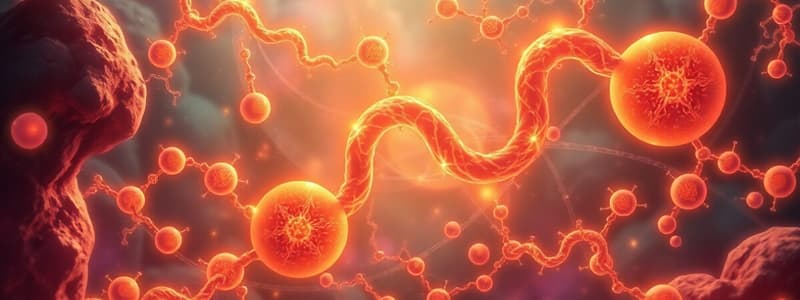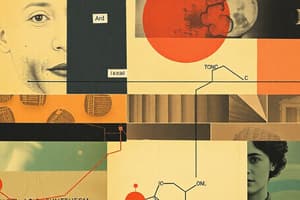Podcast
Questions and Answers
What is the primary end product of fatty acid synthase activity?
What is the primary end product of fatty acid synthase activity?
- Palmitate (correct)
- Oleate
- Linoleate
- Stearate
Which molecule is primarily responsible for supplying NADPH during fatty acid synthesis?
Which molecule is primarily responsible for supplying NADPH during fatty acid synthesis?
- TCA Cycle
- Beta-oxidation
- Pentose Phosphate Pathway (PPP) (correct)
- Glycolysis
What type of reactions occur after each addition of a 2-C unit to the fatty acyl chain?
What type of reactions occur after each addition of a 2-C unit to the fatty acyl chain?
- Reduction reactions (correct)
- Hydrolysis reactions
- Phosphorylation reactions
- Decarboxylation reactions
What is the role of the acyl carrier protein (ACP) segment in fatty acid synthase?
What is the role of the acyl carrier protein (ACP) segment in fatty acid synthase?
What occurs during the cytosolic conversion of malate to pyruvate?
What occurs during the cytosolic conversion of malate to pyruvate?
In which location does fatty acid synthesis primarily occur in adult humans?
In which location does fatty acid synthesis primarily occur in adult humans?
What is the role of acetyl CoA carboxylase in fatty acid synthesis?
What is the role of acetyl CoA carboxylase in fatty acid synthesis?
What effect does a high ATP concentration have on isocitrate dehydrogenase?
What effect does a high ATP concentration have on isocitrate dehydrogenase?
Which of the following is not a reason for upregulation of acetyl CoA carboxylase (ACC) long-term?
Which of the following is not a reason for upregulation of acetyl CoA carboxylase (ACC) long-term?
Which molecule serves as the primary carbon source for the elongation of the fatty acid chain?
Which molecule serves as the primary carbon source for the elongation of the fatty acid chain?
What is the biotin prosthetic group important for in the context of acetyl CoA carboxylase?
What is the biotin prosthetic group important for in the context of acetyl CoA carboxylase?
What type of regulation does AMPK provide to acetyl CoA carboxylase?
What type of regulation does AMPK provide to acetyl CoA carboxylase?
Which of the following statements about fatty acid synthesis is true?
Which of the following statements about fatty acid synthesis is true?
What is the primary donor of carbon in the synthesis of fatty acids?
What is the primary donor of carbon in the synthesis of fatty acids?
Which fatty acid chain length class requires a more complex metabolic pathway including isomerization and redox reactions?
Which fatty acid chain length class requires a more complex metabolic pathway including isomerization and redox reactions?
What role does glycerol play during the fasted state?
What role does glycerol play during the fasted state?
What is the function of carnitine in lipid metabolism?
What is the function of carnitine in lipid metabolism?
Why is Malonyl CoA considered an important regulator in fatty acid oxidation?
Why is Malonyl CoA considered an important regulator in fatty acid oxidation?
What happens to the fate of free fatty acids (FFAs) in the presence of carnitine deficiencies?
What happens to the fate of free fatty acids (FFAs) in the presence of carnitine deficiencies?
Which enzyme is primarily involved in the first reaction of the Carnitine Shuttle?
Which enzyme is primarily involved in the first reaction of the Carnitine Shuttle?
Where does fatty acid oxidation primarily take place within the cell?
Where does fatty acid oxidation primarily take place within the cell?
What primarily affects the liver in CPT-1 deficiency?
What primarily affects the liver in CPT-1 deficiency?
Which condition is associated with CPT-2 deficiency?
Which condition is associated with CPT-2 deficiency?
What is a significant end product of fatty acid β-oxidation?
What is a significant end product of fatty acid β-oxidation?
What role does malonyl-CoA play in fatty acid oxidation regulation?
What role does malonyl-CoA play in fatty acid oxidation regulation?
Which enzyme is inhibited by a high NADH/NAD+ ratio during β-oxidation?
Which enzyme is inhibited by a high NADH/NAD+ ratio during β-oxidation?
What additional enzymes are required for the oxidation of unsaturated fatty acids?
What additional enzymes are required for the oxidation of unsaturated fatty acids?
What are the two fates of fatty acids formed in the liver?
What are the two fates of fatty acids formed in the liver?
How many enzymes have been implicated in inherited diseases related to mitochondrial fatty acid metabolism?
How many enzymes have been implicated in inherited diseases related to mitochondrial fatty acid metabolism?
Flashcards
Fatty Acid Synthesis
Fatty Acid Synthesis
The process of building fatty acids from acetyl CoA units using the enzyme fatty acid synthase. It occurs primarily in the liver, lactating mammary glands, and adipose tissue. Requires ATP and NADPH.
Rate-Limiting Step in FA Synthesis
Rate-Limiting Step in FA Synthesis
The carboxylation of acetyl CoA to form malonyl CoA, catalyzed by acetyl CoA carboxylase (ACC). This step is regulated by both allosteric and covalent mechanisms.
Why is Citrate a Signal for FA Synthesis?
Why is Citrate a Signal for FA Synthesis?
High cellular energy charge (abundant ATP) inhibits isocitrate dehydrogenase, leading to the buildup of citrate. Citrate can readily exit the mitochondria and serve as a precursor for acetyl CoA in the cytosol, facilitating FA synthesis.
Allosteric Regulation of ACC
Allosteric Regulation of ACC
Signup and view all the flashcards
Covalent Regulation of ACC
Covalent Regulation of ACC
Signup and view all the flashcards
Insulin's Role in ACC Regulation
Insulin's Role in ACC Regulation
Signup and view all the flashcards
Biotin's Role in FA Synthesis
Biotin's Role in FA Synthesis
Signup and view all the flashcards
How is Fatty Acid Synthase Involved?
How is Fatty Acid Synthase Involved?
Signup and view all the flashcards
What is the main source of reductant for fatty acid synthesis?
What is the main source of reductant for fatty acid synthesis?
Signup and view all the flashcards
What happens after adding each 2-carbon unit in fatty acid synthesis?
What happens after adding each 2-carbon unit in fatty acid synthesis?
Signup and view all the flashcards
What is the primary end product of fatty acid synthase?
What is the primary end product of fatty acid synthase?
Signup and view all the flashcards
How many subunits does fatty acid synthase have?
How many subunits does fatty acid synthase have?
Signup and view all the flashcards
CPT-1 Deficiency
CPT-1 Deficiency
Signup and view all the flashcards
CPT-1 Deficiency Symptoms
CPT-1 Deficiency Symptoms
Signup and view all the flashcards
CPT-2 Deficiency
CPT-2 Deficiency
Signup and view all the flashcards
CPT-2 Deficiency Symptoms
CPT-2 Deficiency Symptoms
Signup and view all the flashcards
Beta-Oxidation of Fatty Acids
Beta-Oxidation of Fatty Acids
Signup and view all the flashcards
Malonyl-CoA & CPT-1
Malonyl-CoA & CPT-1
Signup and view all the flashcards
Regulation of Beta-Oxidation
Regulation of Beta-Oxidation
Signup and view all the flashcards
Inborn Errors of Fatty Acid Metabolism
Inborn Errors of Fatty Acid Metabolism
Signup and view all the flashcards
Malonyl CoA
Malonyl CoA
Signup and view all the flashcards
NADPH
NADPH
Signup and view all the flashcards
VLCFAs
VLCFAs
Signup and view all the flashcards
Desaturases
Desaturases
Signup and view all the flashcards
Carnitine Shuttle
Carnitine Shuttle
Signup and view all the flashcards
CPT-1
CPT-1
Signup and view all the flashcards
Malonyl CoA Inhibition of CPT-1
Malonyl CoA Inhibition of CPT-1
Signup and view all the flashcards
Sources of Carnitine
Sources of Carnitine
Signup and view all the flashcards
Carnitine Deficiencies
Carnitine Deficiencies
Signup and view all the flashcards
Study Notes
Metabolism of FAs and TAGs
- Fatty acids (FAs) are obtained from the diet or through the conversion of carbohydrates and proteins.
- Excess dietary carbohydrates and proteins can be converted to fatty acids, which are stored as triglycerides (TAGs).
- In adult humans, fatty acid synthesis primarily occurs in the liver, lactating mammary glands, and to a lesser extent, adipose tissue.
Making Fatty Acids
- Many fatty acids are obtained preformed from the diet.
- Excess dietary carbohydrates and proteins can be converted into fatty acids (FAs) and stored as triglycerides (TAGs).
- Fatty acid synthesis takes place in the cytosol of the cell.
- It involves the incorporation of acetyl CoA carbons into the growing fatty acid chain.
- This process is anabolic and requires ATP and NADPH.
Production of cytosolic acetyl coenzyme A
- Acetyl CoA cannot cross the mitochondrial membrane directly.
- Citrate synthase facilitates the condensation of acetyl CoA and oxaloacetate to form citrate.
- Citrate exits the mitochondria.
- Citrate lyase within the cytosol converts citrate back to acetyl-CoA and oxaloacetate.
Carboxylation of acetyl coenzyme A to malonyl coenzyme A
- The carboxylation of acetyl CoA to malonyl CoA is catalyzed by acetyl CoA carboxylase (ACC).
- This step is the rate-limiting and regulated step in fatty acid synthesis.
Fatty Acid Synthase
- Fatty acid synthase sequentially adds two-carbon units (from malonyl CoA) to the growing fatty acid chain, ultimately forming a 16-carbon saturated fatty acid (palmitate).
- The growing chain undergoes two reduction reactions requiring NADPH.
- Fatty acid synthase is a large enzyme with 7 catalytic activities.
- It contains an acyl carrier protein (ACP) that contains a phosphopantetheine residue.
Short-term Regulation of ACC
- Allosteric regulation: citrate activates ACC by promoting its polymerization, Long-chain fatty acyl CoA inhibits ACC by promoting its de-polymerization.
- Covalent regulation by AMPK (AMP-activated protein kinase): AMPK phosphorylates ACC, inactivating it. Insulin dephosphorylates and activates ACC. Glucagon and epinephrine also inhibit ACC.
Long-term Regulation of ACC
- Prolonged consumption of high-carbohydrate diets increases ACC synthesis, promoting fatty acid synthesis.
- Insulin upregulates ACC synthesis through sterol regulatory element-binding protein (SREBP-1).
ACC Contains a Biotin Prosthetic Group
- Biotin acts as a prosthetic group for pyruvate carboxylase during gluconeogenesis.
- Biotin is also a cofactor in ACC catalyzed carboxylation reactions.
Release of FAs from TAG
- Hormone-sensitive lipase (HSL) is activated by hormones (e.g., epinephrine, glucagon) leading to the release of fatty acids.
Fate of Glycerol
- Glycerol enters glycolysis in the fed state.
- During prolonged fasting, it can be converted to glucose.
Fate of FAs
- Note:* Glycerol cannot be metabolized in adipose tissue. It is transported to the liver where it is phosphorylated
FA Oxidation
- Fatty acid oxidation takes place in the mitochondrial matrix.
- Mechanisms for transport of long-chain fatty acyl CoA across membranes are required.
First Reaction of the Carnitine Shuttle
- Catalyzed by a family of acyl-CoA synthetases within the outer mitochondrial membrane.
- This reaction yields fatty acyl-CoA, AMP, and PPi.
LCFA Transported from Cytosol to Mitochondrial Matrix
- Carnitine palmitoyltransferase I (CPT-I) catalyzes the transfer of fatty acyl groups from CoA to carnitine.
- Carnitine acylcarnitine translocase transports acylcarnitine into the mitochondrial matrix.
- Carnitine palmitoyltransferase II (CPT-II) completes the process by transferring the fatty acyl group back to CoA.
Sources of Carnitine
- Carnitine can be obtained from the diet (primarily meat)
- Synthesized in the liver and kidneys from the amino acids lysine and methionine, not skeletal or heart muscle.
Carnitine Deficiencies
- Impaired ability of tissues to use long-chain fatty acids (LCFAs) as fuel.
- Accumulation of toxic amounts of fatty acids and branched-chain acyl groups in cells.
CPT-1 Deficiency
- A genetic defect affecting the liver's ability to use LCFAs for fuel, impairing glucose synthesis during fasting.
- Can lead to severe hypoglycemia, coma, and death.
CPT-2 Deficiency
- Genetic disorder primarily affecting skeletal and cardiac muscle.
- Symptoms range from cardiomyopathy to muscle weakness with myoglobinuria following prolonged exercise.
β-Oxidation of Fatty Acids
- The major pathway for FA catabolism.
- Two-carbon fragments are sequentially removed from the carboxyl end of the fatty acyl CoA.
- End products are acetyl CoA, NADH, and FADH2.
Oxidation of Unsaturated Fatty Acids
- Requires two additional enzymes: an isomerase and a reductase.
Regulation of FA Oxidation
- Controlled by regulating the entry of FAs into the mitochondria.
- Malonyl CoA inhibits CPT-1, preventing futile cycling (simultaneous synthesis and oxidation).
- Enzymes of β-oxidation are regulated by metabolites indicating energy sufficiency (e.g., NADH/NAD+ ratio).
Studying That Suits You
Use AI to generate personalized quizzes and flashcards to suit your learning preferences.



